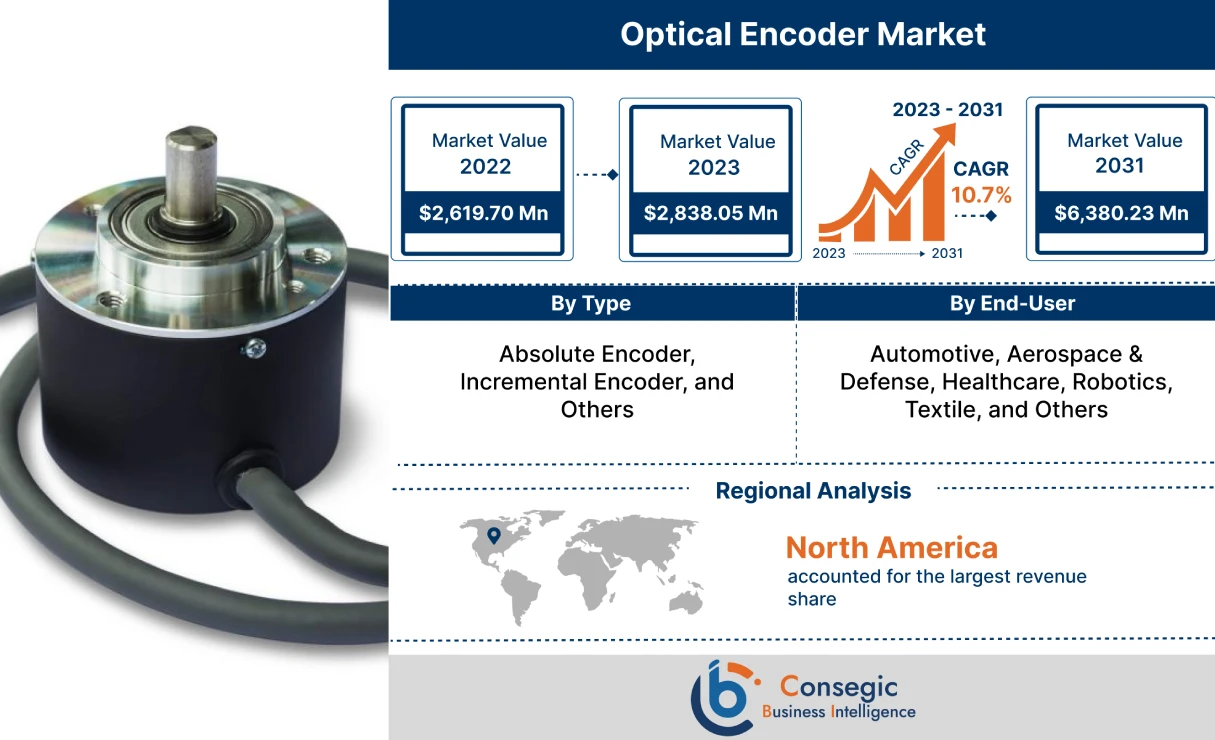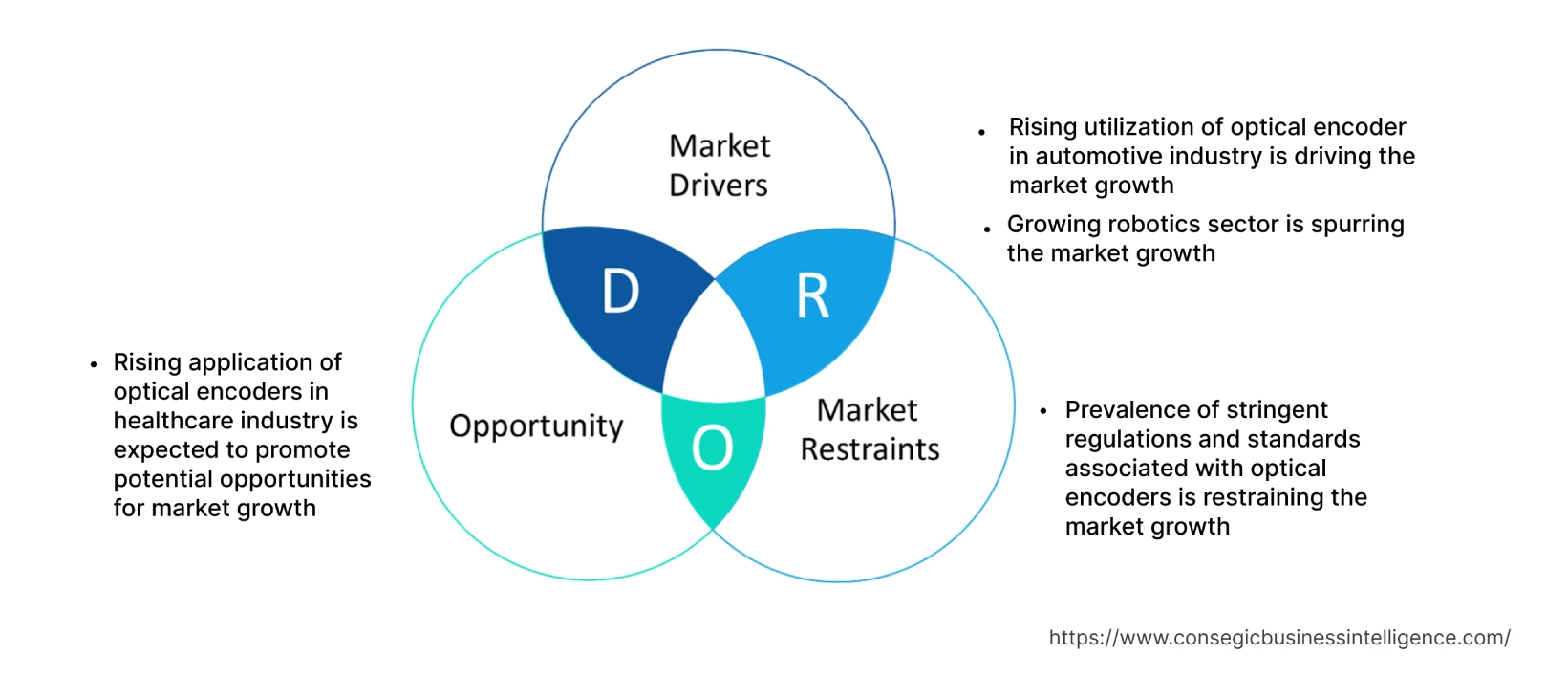- Summary
- Table Of Content
- Methodology
Optical Encoder Market Introduction :
Optical Encoder Market size is estimated to reach over USD 6,380.23 Million by 2031 from a value of USD 2,619.70 Million in 2022 and is projected to grow by USD 2,838.05 Million in 2023, growing at a CAGR of 10.7% from 2023 to 2031.
Optical Encoder Market Definition & Overview:
Optical encoders refer to a type of electromechanical device that utilizes a light source, photosensitive detectors, and an optical grating for converting linear or rotary position to an electrical signal. Moreover, optical encoders offer a range of benefits including high resolution, higher level of accuracy and precision, immunity to electrical noise interference, and flexible mounting options among others. The aforementioned benefits of optical encoders are key determinants for increasing its utilization in automotive, aerospace & defense, healthcare, robotics, textile, and other industries.
Optical Encoder Market Insights :
Key Drivers :
Rising utilization of optical encoder in automotive industry is driving the market growth
Optical encoders are primarily used in the automotive industry for utilization in position sensing and motion control applications using motor drives. Optical encoders are capable of performing a range of functionalities including measurement of position, angle, speed, linear distance, and others, which makes the device ideal for deployment in the automotive industry.
Factors including increasing production of automobiles, advancements in autonomous driving systems, and growing demand for enhanced automobile monition control solutions are primary determinants for driving the adoption of optical encoders. For instance, according to the International Organization of Motor Vehicle Manufacturers, the total volume of automotive production across the world reached up to 85.01 million in 2022, depicting an incline of 6% as compared to 80.14 million in 2021.
Further, according to the European Automobile Manufacturers Association, total passenger car production in the EU reached 10.9 million in 2022, witnessing an increase of 8.3% in contrast to 2021. Thus, the increasing automotive production is driving the deployment of optical encoders for utilization in position sensing and motion control applications using motor drives, in turn proliferating the growth of the market.
Growing robotics sector is spurring the market growth
The deployment of robotics and automation is increasing at a rapid speed in recent years. Optical encoders are primarily used in the robotics for providing feedback and control for arms, wheels, motors, and other moving parts of the robot. Optical encoders are used in robots for recording position, angle, speed, and linear distance. Moreover, the ability of optical encoders to provide the ideal combination of accuracy, resolution, and repeatability makes it ideal for utilization in robotics.
Factors including the rising pace of industrialization, expansion of industrial manufacturing facilities, and growing trend of industrial automation fueled by Industry 4.0 are among the primary aspects driving the growth of the robotics sector.
For instance, according to the International Federation of Robotics, the installation of industrial robots installed in factories across the world reached up to 517,385 units in 2021, depicting a significant growth of 31% in comparison to 2020. Additionally, robot installations in Europe reached up to 84,302 new units in 2021, witnessing an increase of 24% as compared to 2020.
Therefore, the growing installation of robotics is further increasing the utilization of optical encoders for providing feedback and control for arms, wheels, motors, and other moving parts of the robot, in turn driving the market growth.
Key Restraints :
Prevalence of stringent regulations and standards associated with optical encoders is restraining the market growth
Optical encoders are used in various industries including automotive, aerospace & defense, healthcare, and others. However, optical encoder manufacturers have to compulsorily comply with various stringent standards and regulations, which is a prime factor restricting the market growth.
For instance, optical encoder manufacturers have to comply with various standards such as RoHS (Restriction of Hazardous Substances) Directive, ISO (International Organization for Standardization) standard - ISO 9001, and others.
Additionally, optical encoders systems and associated parts must comply with RoHS in relation to Directive 2011/65/EU, including the amendment to Annex II, 2015/863/EU. Further, the quality assurance system and procedures must be audited and certified in compliance with ISO 9001 standard. Therefore, the prevalence of the aforementioned standards associated with the optical encoders is constraining the growth of the market.
Future Opportunities :
Rising application of optical encoders in healthcare industry is expected to promote potential opportunities for market growth
The rising application of optical encoders in the healthcare industry is expected to present potential opportunities for the growth of the optical encoder market. Optical encoders are often used in the healthcare industry, particularly for application in medical devices including imaging and diagnostic devices for motion control and automation applications. Moreover, optical encoders are also used in medical robotic applications for assisting surgeons in surgical tasks requiring dexterity.
Factors including the rise in healthcare expenditure, growing incidence of diagnostics and surgical procedures, and increasing investments in advanced medical equipment are expected to facilitate growth prospects for the market.
For instance, according to American Medical Association, the healthcare spending in the U.S. was valued at USD 4.3 trillion in 2021, representing an incline of 2.7% as compared to 2020. Additionally, healthcare expenditure in the United States accounted for 18.3% of the total GDP in 2021. In addition, the European Commission invested USD 6 billion budget for 2021-27 period with the aim of supporting the healthcare sector in Europe.
Hence, increasing investments in healthcare industry are anticipated to increase the integration of optical encoders for application in medical equipment such as monitoring, diagnostics, and imaging equipment along with medical robotics, in turn promoting opportunities for market growth during the forecast period.
Optical Encoder Market Report Insights :
| Report Attributes | Report Details |
| Study Timeline | 2017-2031 |
| Market Size in 2031 | USD 6,380.23 Million |
| CAGR (2023-2031) | 10.7% |
| By Type | Absolute Encoder, Incremental Encoder, and Others |
| By End-User | Automotive, Aerospace & Defense, Healthcare, Robotics, Textile, and Others |
| By Region | North America, Europe, Asia-Pacific, Latin America, and Middle East & Africa |
| Key Players | Broadcom, Renishaw plc, Bourns Inc., Sensata Technologies Inc., CTS Corporation, Allied Motion Inc., Baumer, FSI Technologies Inc., Exxelia Group, Grayhill Inc., Anaheim Automation Inc., Faulhaber Group |
Optical Encoder Market Segmental Analysis :
Based on the Type :
Based on the type, the market is bifurcated into absolute encoder, incremental encoder, and others. The absolute encoder segment accounted for the largest revenue share of 49.22% in the year 2022. Absolute encoders are a type of optical encoders that are capable of measuring absolute or true angular position. Absolute encoders typically output an analogue signal or a digital data stream such as serial synchronous interface. Moreover, absolute encoders offer several benefits including high immunity to electrical noise, compact design, non-volatility of memory or reliable and accurate position feedback, higher-resolution, accurate motion detection along multiple axes, flexible programming, and others. The above benefits of absolute encoders are further increasing its utilization in aerospace & defense, healthcare, robotics, and other industries.
For instance, Exxelia Group offers AE09 model of absolute encoders in its product portfolio. The absolute encoder features a compact design, high precision, and high reliability among others. The AE09 absolute encoder is designed for applications including aerospace & defense, healthcare, and other industries. Therefore, the rising development of optical encoders for utilization in aerospace & defense, healthcare, and other industries is a prime factor proliferating the growth of the segment.
The incremental encoder segment is anticipated to register the fastest CAGR growth during the forecast period. An incremental encoder is a type of encoder that is designed for converting angular motion or position of a shaft into a digital or analog code for identification of position or motion. Incremental encoders offer multiple benefits including excellent speed and distance feedback, ease of utilization and manufacturing, along with cost-efficiency among others. Additionally, incremental encoders are primarily used in applications including textile, packaging, and other heavy-duty applications.
For instance, in February 2023, POSITAL GmbH launched its new series of incremental encoders integrated with new magnetic sensor technology and embedded microcontrollers with improved energy efficiency. Thus, the rising innovations associated with optical encoders are a vital factor expected to drive the growth of the market during the forecast period.
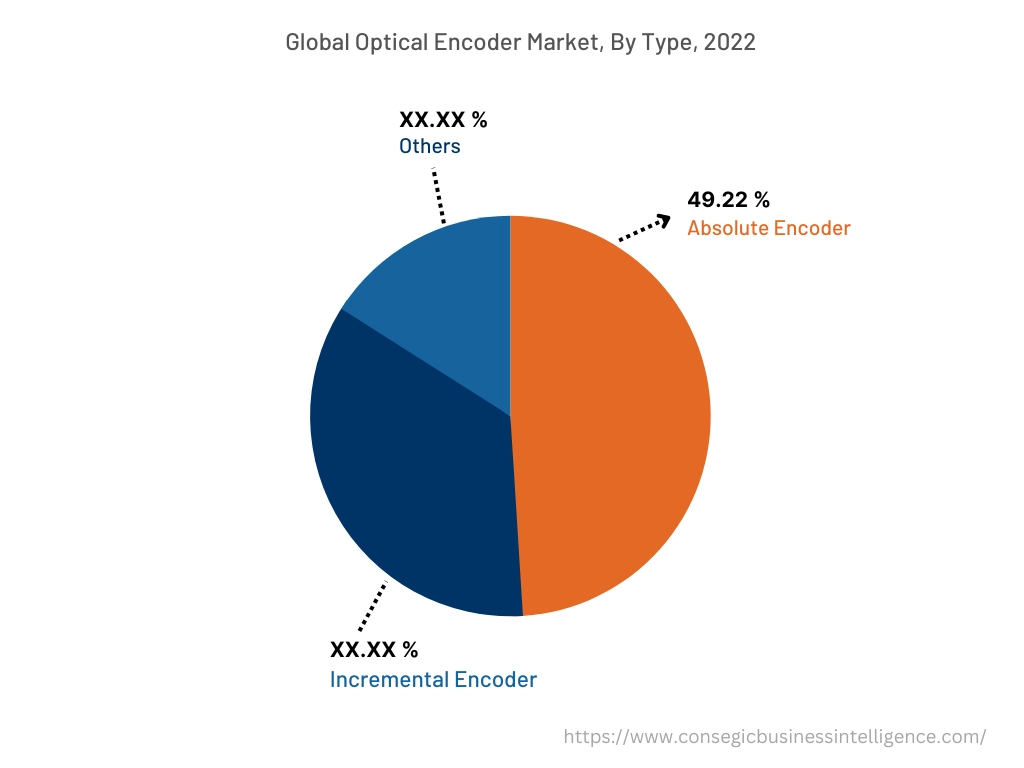
Based on the End-User :
Based on the end-user, the market is segregated into automotive, aerospace & defense, healthcare, robotics, textile, and others. The automotive segment accounted for the largest revenue share in the year 2022. Factors including increasing production of automobiles, advancements in autonomous driving systems, and growing demand for enhanced automobile monition control solutions are driving the growth of the automotive segment.
For instance, Broadcom offers AEDR-9830A series of optical encoders designed for application in automotive industry in its product portfolio. The AEDR-9830A series of optical encoders are optimized for multiple automotive applications including motors, actuators, motion control, and LiDAR among others.
Additionally, according to European Automobile Manufacturers Association, the production volume of passenger cars in the Europe Union reached 10.9 million in 2022, representing a growth of 8.3% in contrast to 2021. Hence, the increasing automotive production is driving the adoption of optical encoders for applications including position sensing and motion control among others, in turn driving the growth of the market.
Aerospace & defense segment is expected to witness fastest CAGR growth during the forecast period. The growth of aerospace & defense segment is attributed to several factors including growing commercial flight activities, rising aircraft production, and increasing investments in air defense systems among others.
For instance, Boeing delivered 99 commercial aircraft during the fourth quarter of 2021, representing a significant incline of 68% in contrast to 59 deliveries during the fourth quarter of 2020. Optical encoders are used in the aerospace & defense industry for applications including motor feedback for actuators, ground support vehicles, and antenna positioning systems along with automated assembly systems for positioning and motion control. Thus, the growth of the aerospace & defense sector is projected to drive the market growth during the forecast period.
Based on the Region :
The regional segment includes North America, Europe, Asia Pacific, Middle East and Africa, and Latin America.
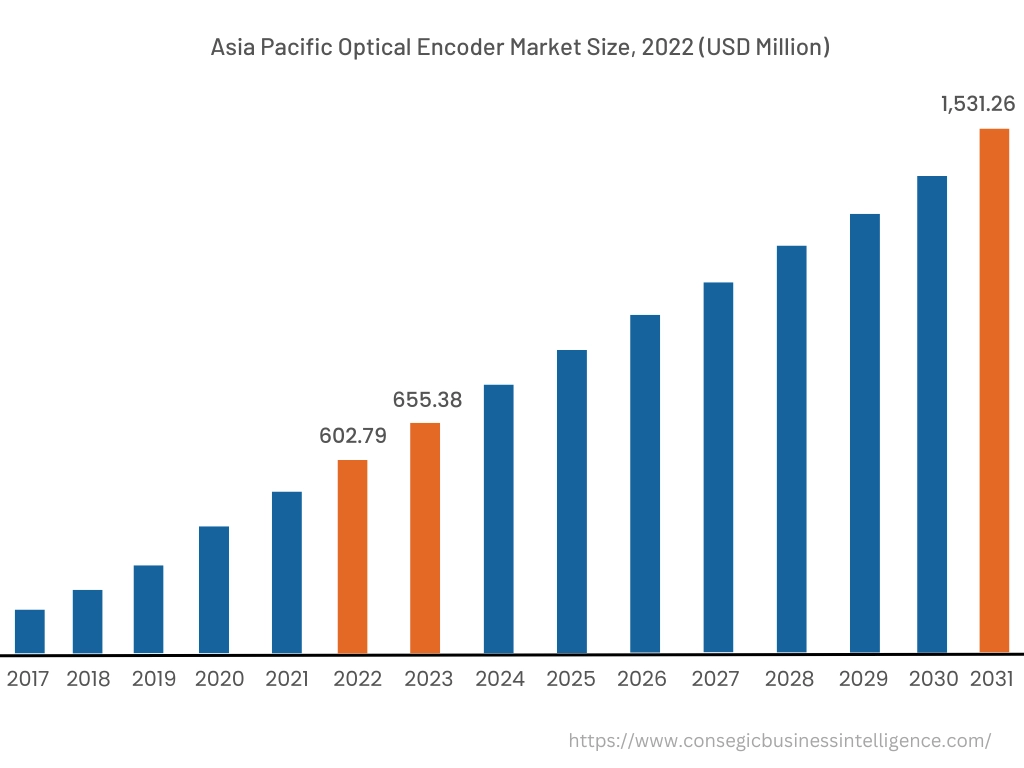
North America is estimated to reach over USD 2,310.92 Million by 2031 from a value of USD 943.35 Million in 2022 and is projected to grow by USD 1,022.48 Million in 2023. The market growth for optical encoders in the North American region is primarily driven by its deployment in automotive, aerospace & defense, healthcare, and other sectors. Moreover, the increasing automotive production and rising utilization of optical encoders in automobiles for position sensing and motion control applications are among the significant factors driving the market growth in the region.
For instance, according to the International Organization of Motor Vehicle Manufacturers, the automobile production in the North American region reached up to 14.79 million in 2022, depicting a growth of 10% in comparison to 13.46 million in 2021. Hence, the growth of automotive industry is boosting the deployment of optical encoders, in turn accelerating market growth in the North American region. In addition, rising investments in electric vehicles and healthcare sectors are projected to boost lucrative growth aspects for the market in North America during the forecast period.
Asia-Pacific is expected to register fastest CAGR growth of 11.2% and is estimated to reach over USD 1,531.26 Million by 2031 from a value of USD 602.79 Million in 2022 and is projected to grow by USD 655.38 Million in 2023. In addition, in the region, the China accounted for the maximum revenue share of 27.3% in the same year. The growing pace of industrialization and development is creating lucrative growth aspects for the market in the region. Additionally, factors including the growth of various industries including robotics, textile, automotive, and others are driving the market growth for optical encoder in the Asia-Pacific region.
For instance, according to the International Federation of Robotics, the installation of industrial robots in China reached 268,195 units in 2021, witnessing a strong growth of 51% as compared to 2020. Meanwhile, installation of industrial robots in Japan reached 47,182 units in 2021, depicting an increase of 22% as compared to 2020. Optical encoders are primarily used in the robotics for providing feedback and control for arms, wheels, motors, and other moving parts of the robot. Therefore, the growing robotics sector in the Asia-Pacific region is anticipated to drive the utilization of optical encoders, thereby, proliferating market growth in the region during the forecast period.
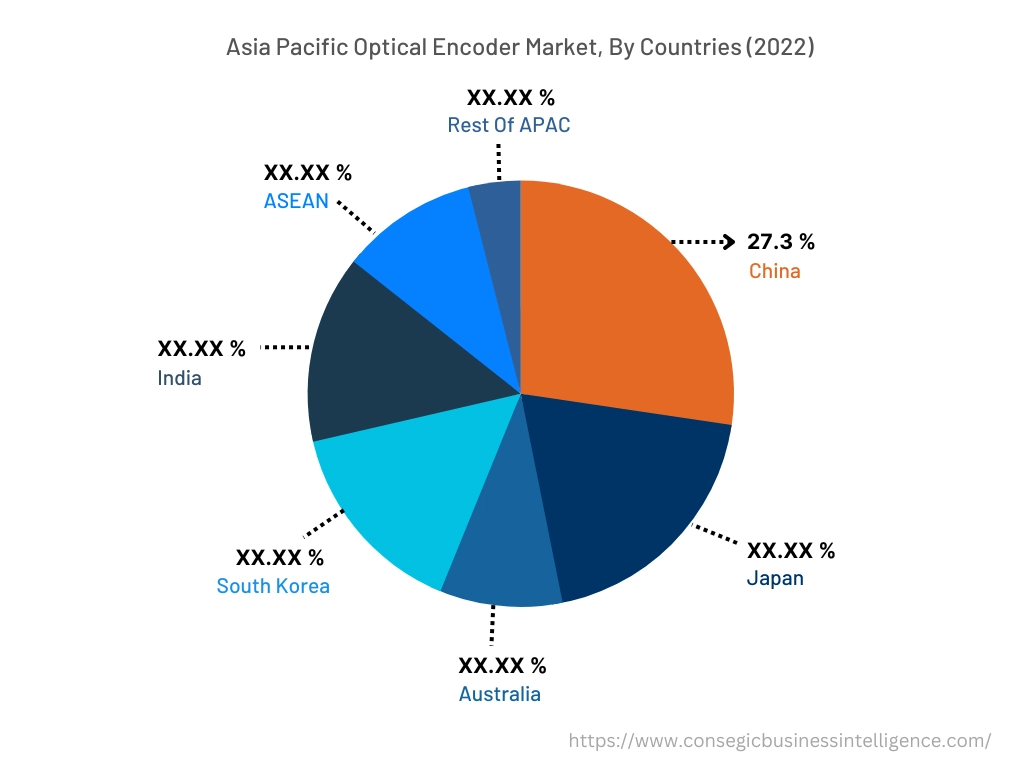
Top Key Players & Market Share Insights:
The optical encoder market is highly competitive with major players providing optical encoder to the national and international markets. Key players are adopting several strategies in research and development (R&D), product innovation, and end-user launches to hold a strong position in optical encoder market. Key players in the optical encoder market include-
- Broadcom
- Renishaw plc
- Exxelia Group
- Grayhill Inc.
- Anaheim Automation Inc.
- Faulhaber Group
- Bourns Inc.
- Sensata Technologies Inc.
- CTS Corporation
- Allied Motion Inc.
- Baumer
- FSI Technologies Inc.
Recent Industry Developments :
- In January 2021, Renishaw plc launched its new FORTiS series of enclosed linear absolute encoder designed for utilization in harsh environments such as machine tools. The FORTiS series of optical encoder provides high resistance to the ingress of solid debris and liquids contaminants.
Key Questions Answered in the Report
What is optical encoder? +
Optical encoders refers to a type of electromechanical device that utilizes a light source, photosensitive detectors, and an optical grating for converting linear or rotary position to an electrical signal.
What specific segmentation details are covered in the optical encoder report, and how is the dominating segment impacting the market growth? +
For instance, by type segment has witnessed absolute encoder as the dominating segment in the year 2022, owing to its increasing utilization in aerospace & defence, healthcare, robotics, and other industries.
What specific segmentation details are covered in the optical encoder market report, and how is the fastest segment anticipated to impact the market growth? +
For instance, by end-user segment has witnessed automotive as the fastest-growing segment during the forecast period due to rising adoption of optical encoder for application in automobile position sensing and motion control among others.
Which region/country is anticipated to witness the highest CAGR during the forecast period, 2023-2031? +
Asia-Pacific is anticipated to register fastest CAGR growth during the forecast period due to rapid pace of industrialization and growth of multiple industries such as robotics, textile, automotive, and others.
